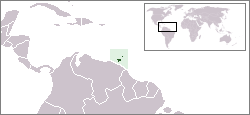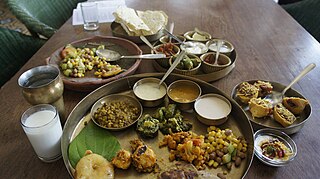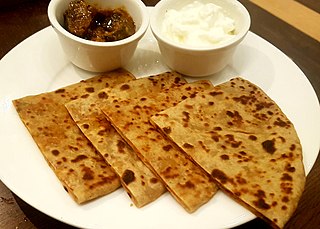
Curry is a dish with a sauce or gravy seasoned with spices, mainly derived from the interchange of Indian cuisine with European taste in food, starting with the Portuguese, followed by the Dutch and British, and then thoroughly internationalised. Many dishes that would be described as curries in English are found in the native cuisines of countries in Southeast Asia and East Asia. The English word is derived indirectly from some combination of Dravidian words such as the Tamil kaṟi (கறி) meaning 'sauce' or 'relish for rice'.

Pakistani cuisine is a blend of regional cooking styles and flavours from across South, Central and West Asia. It is a culmination of Iranic, Indic & Arab culinary traditions. The cuisine of Pakistan also maintains certain Mughal influences within its recipes and cooking techniques, particularly the use of dried fruits and nuts. Pakistan's ethnic and cultural diversity, diverse climates, geographical environments, and availability of different produce lead to diverse regional cuisines.

Vindaloo or Vindalho is a Goan curry dish, based on the Portuguese dish carne de vinha d'alhos. It is known globally in its British Indian form as a staple of curry house and Indian restaurant menus and is often regarded as a fiery, spicy dish. The traditional recipe uses pork, but alternative versions have been prepared with beef, mutton, prawns, chicken, lamb, vegetables and tofu.

Mashed potato or mashed potatoes, colloquially known as mash, is a dish made by mashing boiled or steamed potatoes, usually with added milk, butter, salt and pepper. It is generally served as a side dish to meat or vegetables. Roughly mashed potatoes are sometimes called smashed potatoes. Dehydrated instant mashed potatoes and frozen mashed potatoes are available. Mashed potatoes are an ingredient in other dishes, such as dumplings and gnocchi.

Trinidad and Tobago cuisine is influenced by Indian-South Asian, West African, Creole, European, North American, Chinese, Amerindian, Latin American, and Levantine culinary styles.

Aloo gobhi, aloo gobi or alu gobhi is a vegetarian dish from the Indian subcontinent made with potatoes (aloo), cauliflower (gobhi), and Indian spices. It is popular in Indian cuisine. It is yellowish in color due to the use of turmeric, and occasionally contains black cumin and curry leaves. Other common ingredients include garlic, ginger, onion, coriander stalks, tomato, peas, black pepper, asafoetida and cumin. There are a number of variations and similar dishes.

Biryani is a mixed rice dish popular in South Asia, made with rice, meat or seafood, and spices. To cater to vegetarians, vegetables or paneer can be substituted for the meat or seafood. Sometimes eggs or potatoes are also added.

Mattar paneer, also known as matar paneer, muttar paneer, and mutter paneer, is a modern restaurant-style and vegetarian North Indian dish consisting of peas and paneer in a tomato-based sauce, spiced with garam masala.

Gujarati cuisine is the cuisine of the Indian state of Gujarat. The typical Gujarati thali consists of rotli, dal or curry, rice, and shaak. The thali will also include preparations made from pulses or whole beans such as moong, black eyed beans etc., a snack item (farsaan) like dhokla, pathra, samosa, fafda, etc. and a sweet (mishthaan) like mohanthal, jalebi, sevaiya etc.

Sindhi cuisine refers to the distinct native cuisine of the Sindhi people from Sindh, Pakistan. Sindhi cuisine has been influenced by Central Asian, Iranian, Mughal food traditions. It is mostly a non-vegetarian cuisine, with even Sindhi Hindus widely accepting of meat consumption. The daily food in most Sindhi households consists of wheat-based flat-bread (Mani) or rice accompanied by two dishes, one gravy and one dry with curd, papad or pickle. Freshwater fish and a wide variety of vegetables are usually used in Sindhi cuisine. Restaurants specializing in Sindhi cuisine are rare, although it is found at truck stops in rural areas of Sindh province, and in a few restaurants in urban Sindh.

Dopiaza is the name of two separate dishes, one in the Greater Iran region and one in South Asia. It refers to a family of recipes, typically meat-based, that contain onions as a major ingredient. There are two alternative etymological explanations for its name.
- Onions are added at two stages of cooking: chopped or ground in the marinade/gravy, and as a garnish/topping, either pickled or crisply fried.
- The recipe uses onions and meat in a 2:1 ratio.
Potato cake is a name given to various shaped potato dishes around the world, including a patty of hashed potatoes, a fried patty of mashed potato, a fried and battered slice of potato, or a flatbread made with mashed potato and flour. In Northern England and some states in Australia, a thin slice of potato that is battered and deep fried may be called a potato scallop. In Australia and New Zealand, the terms potato cake, potato flip and potato fritter may be used.
Bhojpuri cuisine is a style of food preparation common among the Bhojpuri people of Bihar, Jharkhand and eastern Uttar Pradesh in India, and also the Terai region of Nepal. Bhojpuri foods are mostly mild and tend to be less hot in terms of spices used. The cuisine consists of both vegetable and meat dishes.
Bihari cuisine is eaten mainly in the eastern Indian state of Bihar, as well as in the places where people originating from the state of Bihar have settled: Jharkhand, Eastern Uttar Pradesh, Bangladesh, Nepal, Mauritius, South Africa, Fiji, some cities of Pakistan, Guyana, Trinidad and Tobago, Suriname, Jamaica, and the Caribbean. Bihari cuisine includes Angika cuisine, Bhojpuri cuisine, Maithil cuisine and Magahi cuisine. Dal Puri

Aloo paratha is a paratha stuffed with potato filling native to the Indian subcontinent. It is traditionally eaten for breakfast.

Aloo gosht is a meat curry, and is a popular dish in North Indian, Pakistani, and Bangladeshi cuisine. It consists of potatoes (aloo) cooked with meat (gosht), usually lamb or mutton or beef, in a stew-like shorba gravy. It may be considered a curry, stew, or shorba depending on the way the dish is prepared, the types of spices used and what country or particular region it was made in. The dish can be served and eaten with plain rice or with bread such as roti, paratha or naan.

Paratha is a flatbread native to the Indian subcontinent, with earliest reference mentioned in early medieval Sanskrit, India; prevalent throughout the modern-day countries of India, Pakistan, Nepal, Bangladesh, Maldives, Afghanistan, Myanmar, Malaysia, Singapore, Thailand, Mauritius, Fiji, Guyana, Suriname, and Trinidad and Tobago where wheat is the traditional staple. It is one of the most popular flatbreads in the Indian subcontinent and the Middle East. Paratha is an amalgamation of the words parat and atta, which literally means layers of cooked dough. Alternative spellings and names include parantha, parauntha, prontha, parontay, paronthi (Punjabi), porota, paratha, palata, porotha, forota, faravatha, farata, prata, paratha, buss-up shut, oil roti and roti canai in Malaysia and Indonesia.

Bombay potato is an Indian dish prepared using potatoes that are cubed, parboiled and then fried and seasoned with various spices such as cumin, curry, garlic, garam masala, turmeric, mustard seeds, chili powder, salt and pepper. Onion, tomatoes and tomato sauce are sometimes used as ingredients. Bombay potato can also be served as a side dish, rather than as a main course.

Keema matar, also rendered Qeema matar, is a dish from the Indian subcontinent associated with the Mughals. The term is derived from Chaghatai Turkic قیمه which is cognate with Turkish kıyma.
Dhoper chop is a snack originating from the Indian subcontinent, in West Bengal preparation, it is a huge egg-shaped snack in a bread jacket with ketchup and onion salad and sometimes with a cup of tea.
















